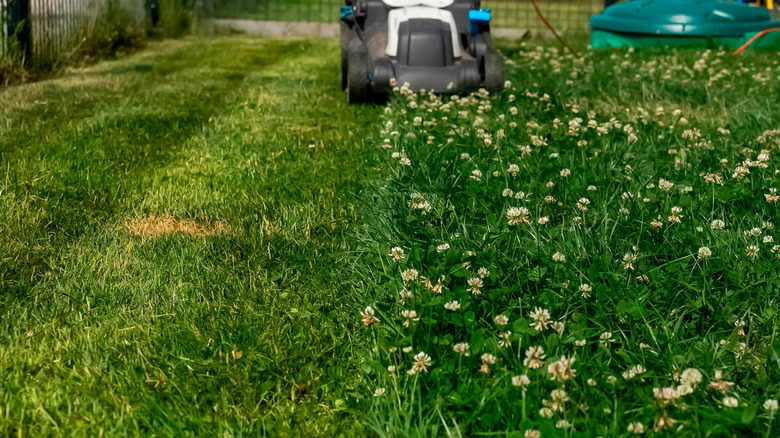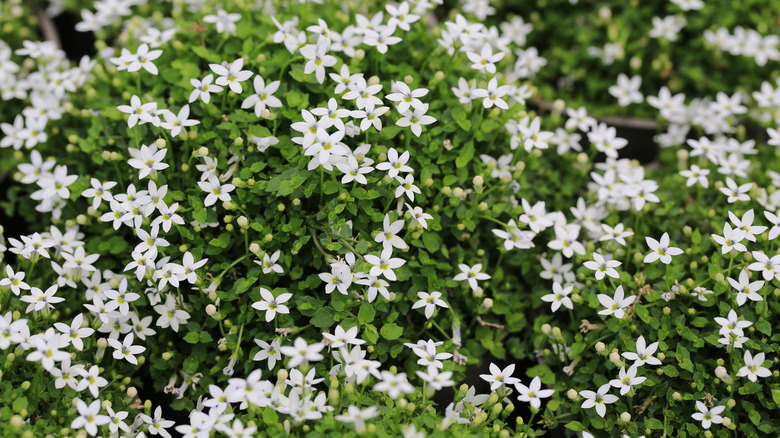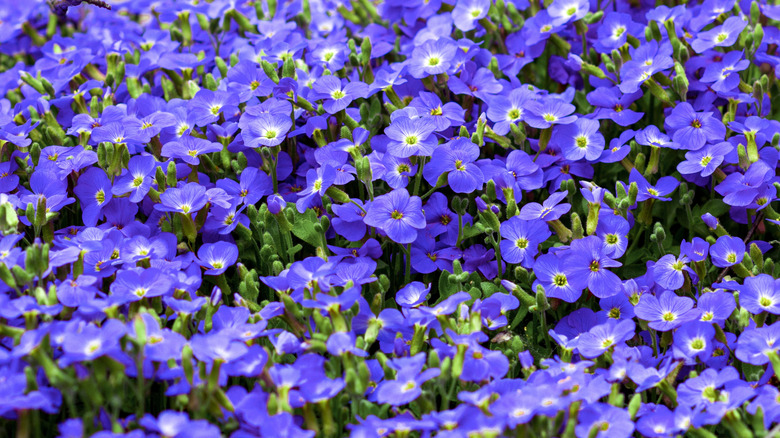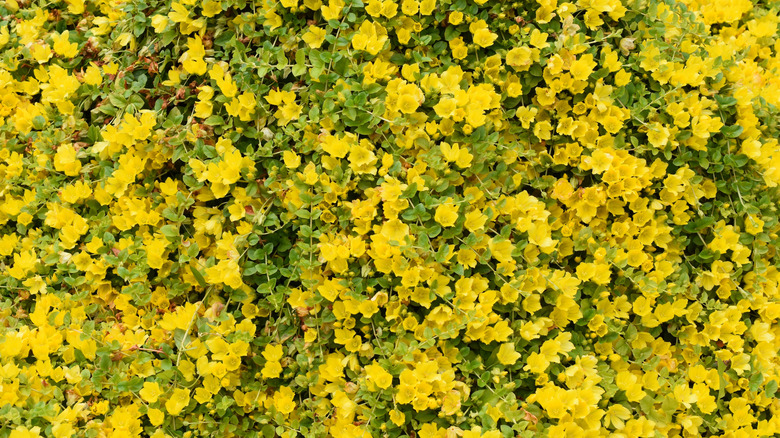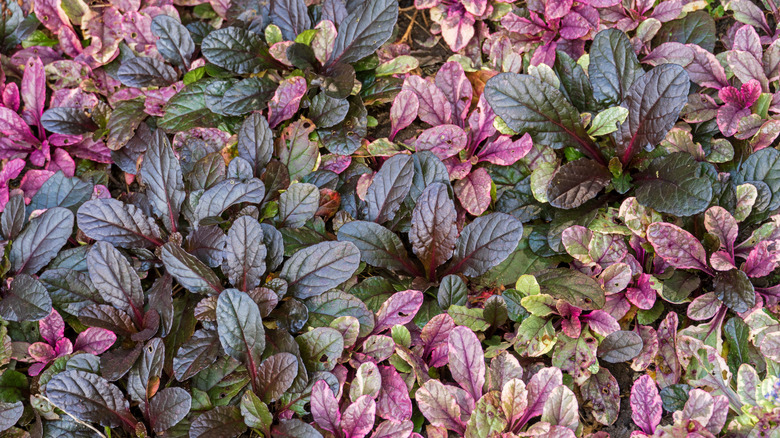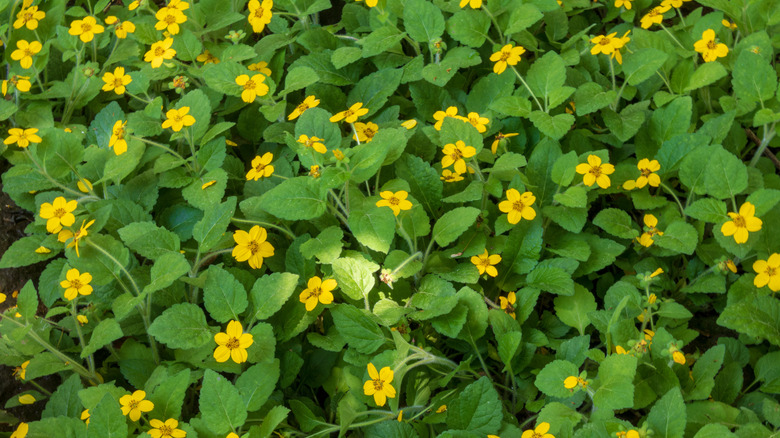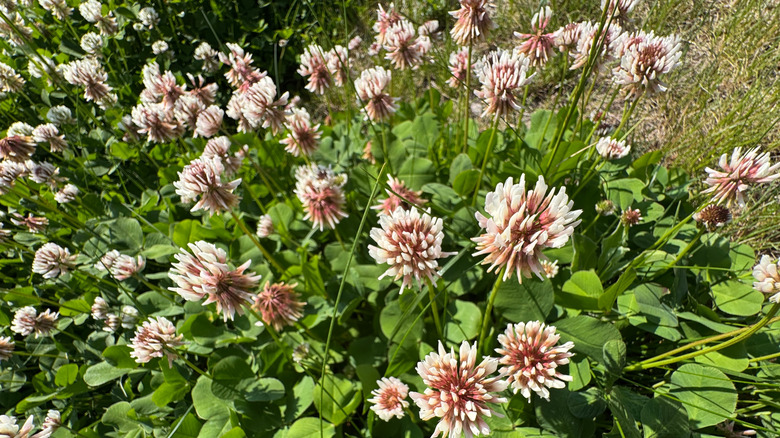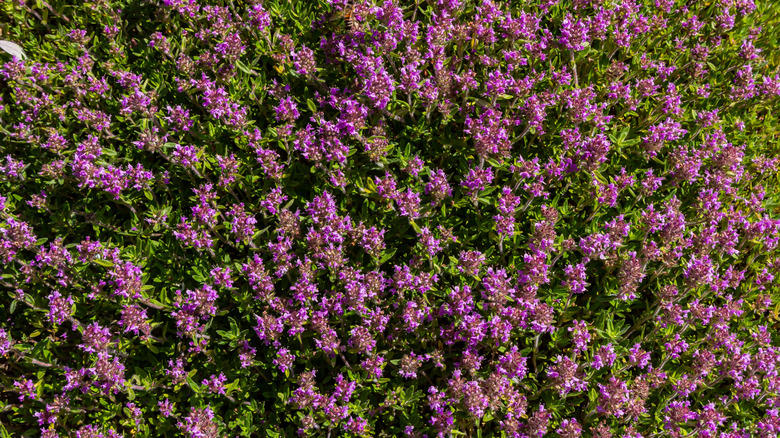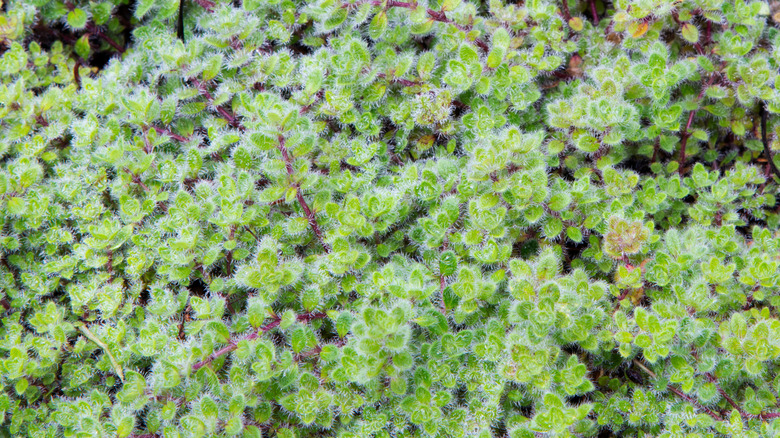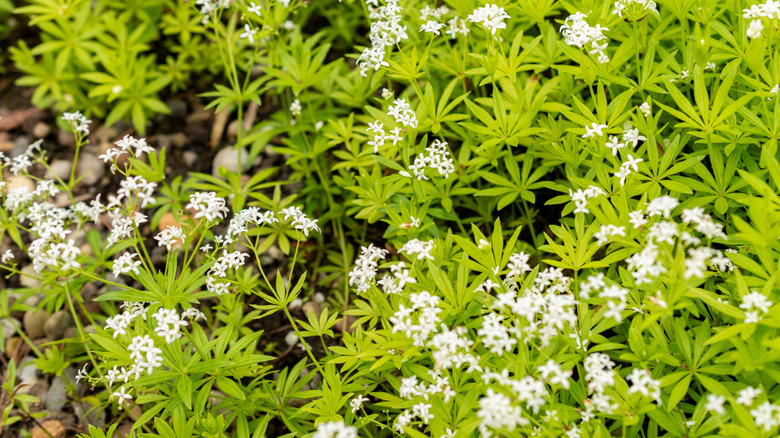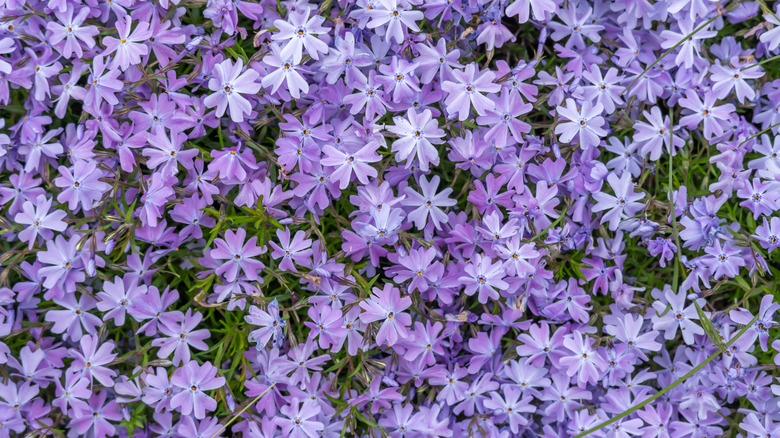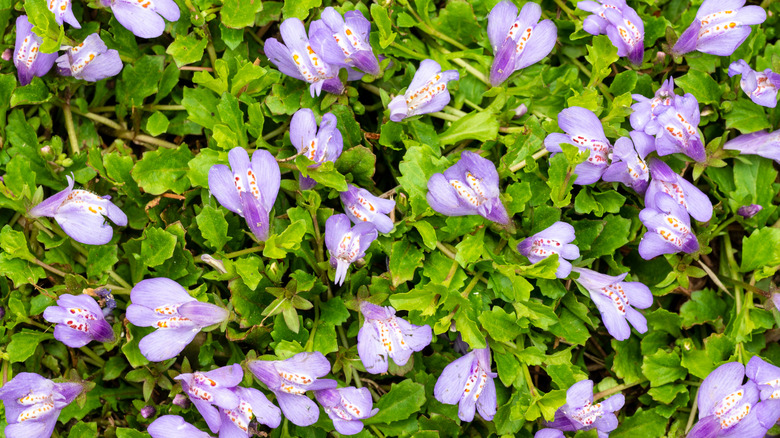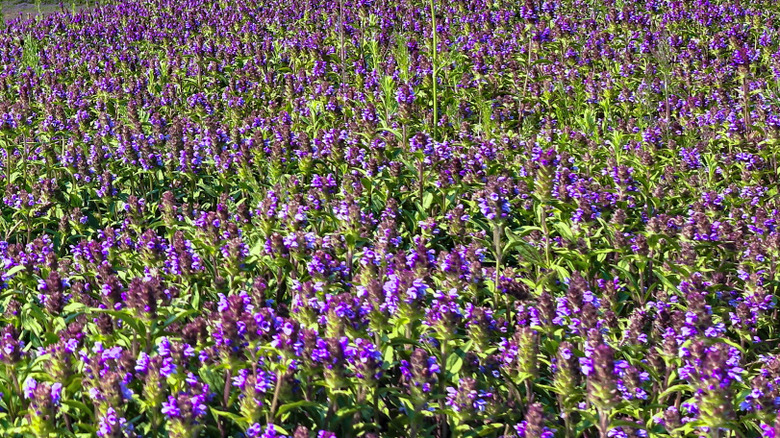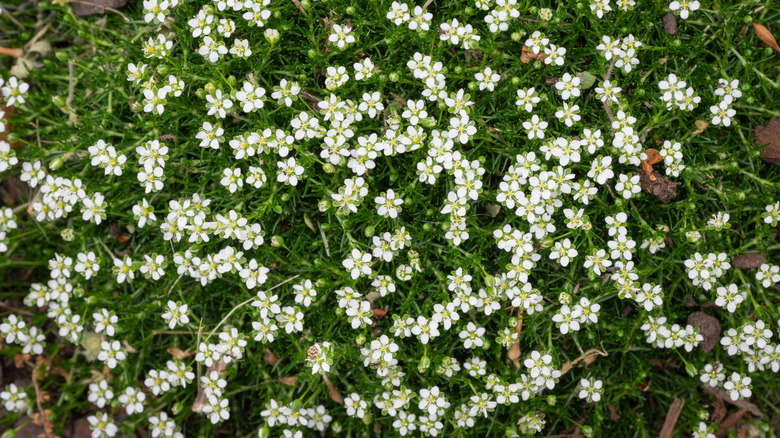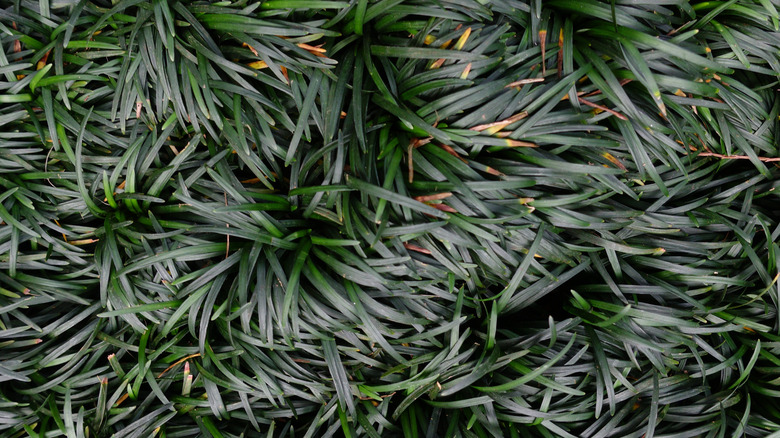18 Best Grass Alternatives To Grow A Bright, Beautiful, Colorful Yard
"Ground cover" must surely be the most lukewarm label we apply to some genuinely lovely and useful plants. It's like calling your (also lovely and useful) spouse "the dishwasher." Many ground covers do more than just shade the soil. They are useful for water conservation, choking out weeds, and controlling erosion. But, when you use a ground cover as an alternative to turfgrass for a lawn, there's one big benefit you might not have considered: color.
Your ground cover color choices are nearly limitless. Your goal can be as modest as replacing winter's dormant grass with the stunning, year-round color of evergreen ground covers, or it can be as dramatic as the technicolor showiness of winter heath. There's an endless array and depth of colors to choose from, and frankly, even the dullest is an improvement over the best crop of grass.
Of course, not every ground cover is a good replacement for turfgrass. Be sure to think about what USDA Hardiness Zone you live in and how much sun your plot of dirt gets. And if you want a grass alternative that's more, well, grass-like — low-growing and tolerant of foot traffic — take note of that, too.
Blue star creeper deserves a better name
Blue star creeper (Laurentia fluviatilis) is a 4-inch, deep-green ground cover with a delicate look and enough durability to handle the kids on a weekend. It blooms spring through summer in white and pale blues. Plant blue star creeper in full sun with afternoon shade, though it can also deal with partial shade. Like the majority of plants on earth, it prefers moist and well-drained soil, but it's hardy and can deal with less-than-ideal circumstances.
Speedwell has a better name ... Veronica
Speedwell (Veronica repens) can blanket your lawn with 2 to 5 inches of dark evergreen foliage. It's able to handle major foot traffic and gives you a haze of white to lavender flowers in spring. Plant it in full or partial sun in zones 4 through 8. While Veronica prefers the usual moist, well-drained soil (let's just go ahead and call it "MWDS" in the interest of conserving precious pixels), it's not particularly picky and can handle the soil of an average lawn just fine.
Creeping Jenny turns out to be a pretty good Jenny
With a name like "golden moneywort," you might know it wouldn't grow on trees. This ground cover is more commonly known as creeping Jenny (Lysimachia nummularia), and it's a 2 inch, fast-growing marvel with foliage that ranges from green to gold. Look for its yellow cup-shaped flowers most of the summer in zones 3 through 9, where it can handle soil that's a bit drier than the usual MWDS and is also good for slopes and shady areas.
Bugleweed sounds the trumpet for ditching the word weed
Bugleweed (Ajuga reptans), sometimes called carpet bugleweed, doesn't create much of an impression of either bugles or weeds. But you will definitely get a carpet vibe from its 2 to 6 inch foliage, interrupted in spring with miniature purple blooms that appear in both spring and fall. Bugleweed is one of the ground cover plants that can deter deer from grazing in your yard. It's not all that foot-traffic-friendly and likes a bit of shade, but it can cope with full sun and soil that's all over the moistness map.
Green-and-gold will neither surprise nor disappoint
Green-and-gold (Chrysogonum virginianum) is a native perennial that can stay low or grow to 6 inches, depending on the variety. It has light green foliage and bright yellow spring and early summer flowers. In zones 5 through 9 it will thrive, but it might go dormant in winter in colder areas. Green and gold likes its MWDS, though it's a little more flexible with sunlight, ranging in preference from full sun to partial shade.
Clover (and microclover) aren't the weeds in your lawn
Common clover is often thought of as a lawn weed, but it has a lot going for it as a lawn replacement. White or Dutch clover (Trifolium repens) is the most common variety, and it stays greener longer than grass can hope to. A smaller variety called microclover has gained traction in recent years as a grass replacement. It forms a denser mat that can keep weeds (like that pesky turfgrass) at bay, and because it doesn't bloom, it doesn't draw bees to your lawn. You decide if that's a good thing.
Creeping thyme is always a good thyme
Creeping thyme (Thymus serpyllum) might be the most commonly discussed lawn alternative after microclover. This 1 to 3 inch tall herb blooms in spring and comes in a number of different-colored varieties. It grows in zones 4 through 9 and likes well-drained soil but could take or leave the moistness and, in fact, doesn't do well in wet soil — moderate to low water levels are ideal. Opinions differ on how much foot traffic creeping thyme can take, but it certainly smells great when you step on it.
If you have a dry, sunny lawn, it's woolly thyme
Woolly thyme (Thymus pseudolanuginosus, which means "false wool," in case you're confused about where wool comes from) is a less fragrant thyme that brings color to your lawn with its gray-green foliage and pale pink summer flowers. It grows happily in dry soil and full sun and, once established, is extremely low-maintenance. It grows in zones 5 through 8, but might not be cold-hardy in the more northern extremes of that range.
Sweet woodruff lives downstairs from sweet William
Sweet woodruff (Galium odoratum) is a fast-growing, shade-loving ground cover that grows to between 6 and 12 inches tall. It blooms with fragrant white flowers in spring and often grows so well that it can be a pain for those not looking for a lawn replacement. This plant is better for out-of-the-way areas, since it doesn't handle foot traffic well. Sweet woodruff should be grown in zones 4 through 8 and it needs a bit of moisture throughout the growing season.
The beauty of creeping phlox will sneak up on you
Creeping phlox (Phlox subulata) is a 6 inch tall, low-growing variety of phlox that shows off in a riot of spring flowers that can include white, pink, purple, and blue. The semi-evergreen foliage is delicate, tolerating only light foot traffic, but it provides excellent erosion control and a long flowering season. Grow creeping phlox in zones 3 through 9 in just about any sort of soil, so long as it's well-drained.
Creeping mazus had to be tough with a name like that
Creeping mazus (Mazus reptans) is a pleasure and a trooper. It's fast-growing, can take a beating from foot traffic and mowing, and shows its indifference to such treatment by rewarding you with purple-blue spring and early summer flowers. Mazus loves moisture, but otherwise can deal with whatever soil you stick it in. Grow this 3 to 4 inch tall perennial ground cover in zones 5 through 8 in full sun to partial shade.
Selfheal can cure your lawn
Selfheal (Prunella vulgaris ssp. lanceolata) is an 8 to 12 inch native perennial that's a particular favorite of pollinators like bees and butterflies when its purple flowers bloom from mid-summer to fall. Grass farmers often consider selfheal a weed, but others consider it a plant with an unusual array of medicinal properties. Grow it in zones 4 through 9 in MWDS. It'll do best in full sun, but in hot southern climates, selfheal might benefit from partial shade.
Irish moss is shorter and more poetic than Scottish moss, and has better whisky
Irish moss (Sagina subulata) is not a moss at all, but rather an evergreen perennial related to carnations that prefers a lot of sun and will reward you with a carpet of delicate, light green foliage and little white flowers in spring and summer. It handles a little foot traffic well and only reaches about 1 inch tall in full sun. Grow Irish moss in zones 4 through 8 and keep its soil moist. It prefers nutrient-rich soil.
Dwarf mondo grass means small large grass, and it's true
Dwarf mondo grass (Ophiopogon japonicus 'Nana') gives you a lot of the benefits of turfgrass, but without the mowing. It's grass-like, to be sure, and it fares well in shade — which few grasses are great at. The plant is deep green and luxurious in both appearance and feel. It copes with foot traffic without a hitch. Mondo grass likes moist soil ... MWDS, in fact ... which is especially important if it's planted in a sunny spot. Plant it in zones 6 through 11.
Call it turkey tangle fogfruit and keep the name alive
Frogfruit (Phyla nodiflora) is an evergreen native perennial that's sometimes known as, and should always be known as, turkey tangle fogfruit. This member of the verbena family can grow up to 6 inches tall and attracts butterflies all year with its white, red, and pink flowers. It can handle a little foot traffic and actually benefits from an occasional mowing to 4 inches. It grows in zones 8 through 11 and can handle a variety of soil and sun conditions.
Sedum? How could you miss dem?
Sedum spurium, also known as two-row stonecrop, is a 3 to 6 inch tall ground cover hardy in zones 3 through 11 that can spread 2 to 3 feet and handle moderate foot traffic. Provide creeping sedum with well-drained soil and a fair amount of light — full sun to light shade — and you'll get a grass alternative with drought-tolerant fleshy leaves and late-summer blooms in white, pink, orange, and yellow. Sedum brings color the rest of the year through a wide variety of foliage coloration and variegation. Avoid planting in areas where water stands for any length of time.
Chamomile quits lawns to a tea
Chamomile (Chamaemelum nobile) is an evergreen perennial in the daisy family that you're more likely to think of as a tea or a cosmetic ingredient. It's a 3 to 12 inch ground cover that serves fairly well as a lawn substitute, including tolerating very light foot traffic and occasional mowing. In warm regions you can enjoy the fragrant herb year-round, and its little yellow-centered white flowers provide summer or early fall color. Give it well-drained soil in zones 4 through 9 along with full sun to partial shade, dialing back the sun a little in southern climates.
Carex, for when you want grass but not really
Carex is a genus of sedges, some of which serve well as a ground cover and grass alternative in zones 3 through 9. Carex might be the most obvious option to replace your lawn, since it can be aggressive and looks and acts a lot like a turfgrass. It's bladed and can be mowed as you desire, but is generally more drought-tolerant and less fertilizer-hungry than grass. It tends to display a pleasant light-green, sometimes variegated foliage and adds more color in spring via grain-like blooms in colors from white to yellow to pink.
